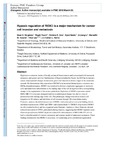Hypoxic regulation of RIOK3 is a major mechanism for cancer cell invasion and metastasis
| dc.contributor.author | Singleton, DC | |
| dc.contributor.author | Rouhi, P | |
| dc.contributor.author | Zois, CE | |
| dc.contributor.author | Haider, S | |
| dc.contributor.author | Li, J-L | |
| dc.contributor.author | Kessler, BM | |
| dc.contributor.author | Cao, Y | |
| dc.contributor.author | Harris, AL | |
| dc.date.accessioned | 2017-11-27T15:12:21Z | |
| dc.date.available | 2017-11-27T15:12:21Z | |
| dc.date.issued | 2015-09-03 | |
| dc.identifier.issn | 0950-9232 | |
| dc.identifier.issn | 1476-5594 | |
| dc.identifier.uri | http://hdl.handle.net/10026.1/10286 | |
| dc.description.abstract |
Hypoxia is a common feature of locally advanced breast cancers that is associated with increased metastasis and poorer survival. Stabilisation of hypoxia-inducible factor-1α (HIF1α) in tumours causes transcriptional changes in numerous genes that function at distinct stages of the metastatic cascade. We demonstrate that expression of RIOK3 (RIght Open reading frame kinase 3) was increased during hypoxic exposure in an HIF1α-dependent manner. RIOK3 was localised to distinct cytoplasmic aggregates in normoxic cells and underwent redistribution to the leading edge of the cell in hypoxia with a corresponding change in the organisation of the actin cytoskeleton. Depletion of RIOK3 expression caused MDA-MB-231 to become elongated and this morphological change was due to a loss of protraction at the trailing edge of the cell. This phenotypic change resulted in reduced cell migration in two-dimensional cultures and inhibition of cell invasion through three-dimensional extracellular matrix. Proteomic analysis identified interactions of RIOK3 with actin and several actin-binding factors including tropomyosins (TPM3 and TPM4) and tropomodulin 3. Depletion of RIOK3 in cells resulted in fewer and less organised actin filaments. Analysis of these filaments showed reduced association of TPM3, particularly during hypoxia, suggesting that RIOK3 regulates actin filament specialisation. RIOK3 depletion reduced the dissemination of MDA-MB-231 cells in both a zebrafish model of systemic metastasis and a mouse model of pulmonary metastasis. These findings demonstrate that RIOK3 is necessary for maintaining actin cytoskeletal organisation required for migration and invasion, biological processes that are necessary for hypoxia-driven metastasis. | |
| dc.format.extent | 4713-4722 | |
| dc.format.medium | Print-Electronic | |
| dc.language | en | |
| dc.language.iso | eng | |
| dc.publisher | Springer Science and Business Media LLC | |
| dc.subject | Actin Cytoskeleton | |
| dc.subject | Animals | |
| dc.subject | Breast Neoplasms | |
| dc.subject | Cell Hypoxia | |
| dc.subject | Cell Line, Tumor | |
| dc.subject | Cell Movement | |
| dc.subject | Gene Expression Regulation, Neoplastic | |
| dc.subject | Humans | |
| dc.subject | Hypoxia-Inducible Factor 1, alpha Subunit | |
| dc.subject | Mice | |
| dc.subject | Neoplasm Invasiveness | |
| dc.subject | Neoplasm Metastasis | |
| dc.subject | Protein Serine-Threonine Kinases | |
| dc.subject | Tropomyosin | |
| dc.subject | Zebrafish | |
| dc.title | Hypoxic regulation of RIOK3 is a major mechanism for cancer cell invasion and metastasis | |
| dc.type | journal-article | |
| dc.type | Article | |
| plymouth.author-url | https://www.ncbi.nlm.nih.gov/pubmed/25486436 | |
| plymouth.issue | 36 | |
| plymouth.volume | 34 | |
| plymouth.publication-status | Published | |
| plymouth.journal | Oncogene | |
| dc.identifier.doi | 10.1038/onc.2014.396 | |
| plymouth.organisational-group | /Plymouth | |
| plymouth.organisational-group | /Plymouth/REF 2021 Researchers by UoA | |
| plymouth.organisational-group | /Plymouth/REF 2021 Researchers by UoA/UoA01 Clinical Medicine | |
| plymouth.organisational-group | /Plymouth/REF 2021 Researchers by UoA/UoA01 Clinical Medicine/UoA01 Clinical Medicine | |
| dc.publisher.place | England | |
| dcterms.dateAccepted | 2014-10-20 | |
| dc.identifier.eissn | 1476-5594 | |
| dc.rights.embargoperiod | Not known | |
| rioxxterms.versionofrecord | 10.1038/onc.2014.396 | |
| rioxxterms.licenseref.uri | http://www.rioxx.net/licenses/all-rights-reserved | |
| rioxxterms.licenseref.startdate | 2015-09-03 | |
| rioxxterms.type | Journal Article/Review |


